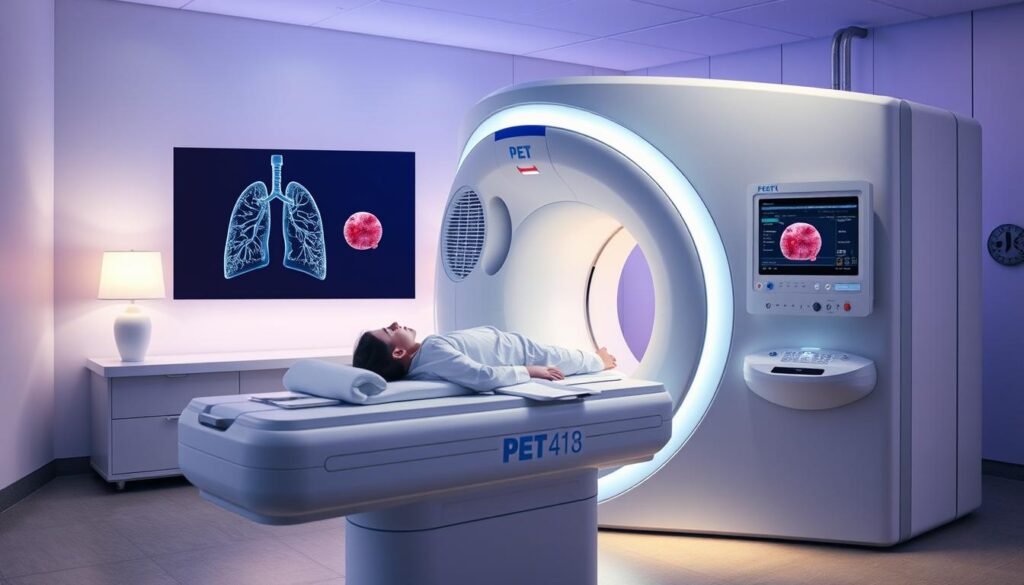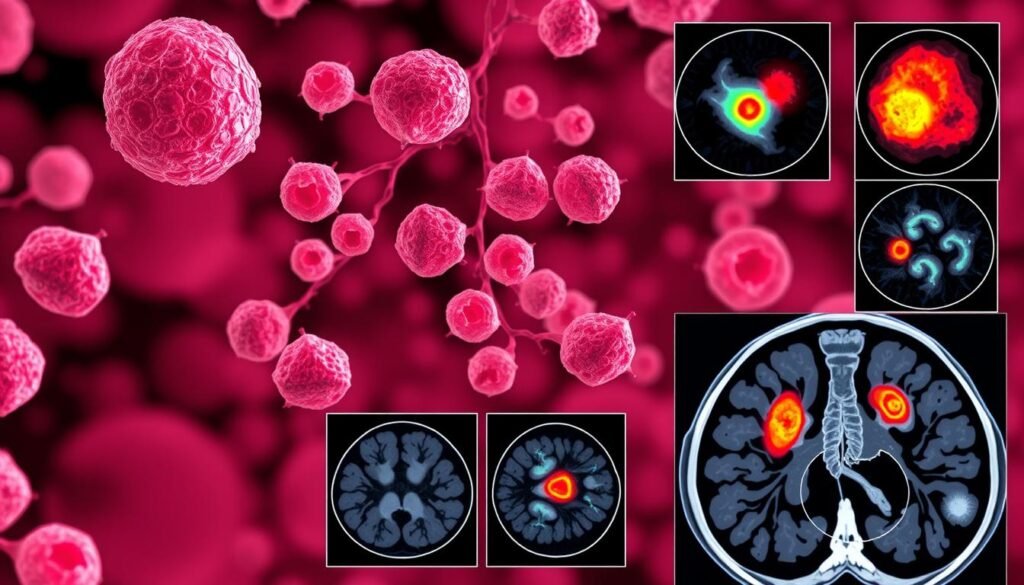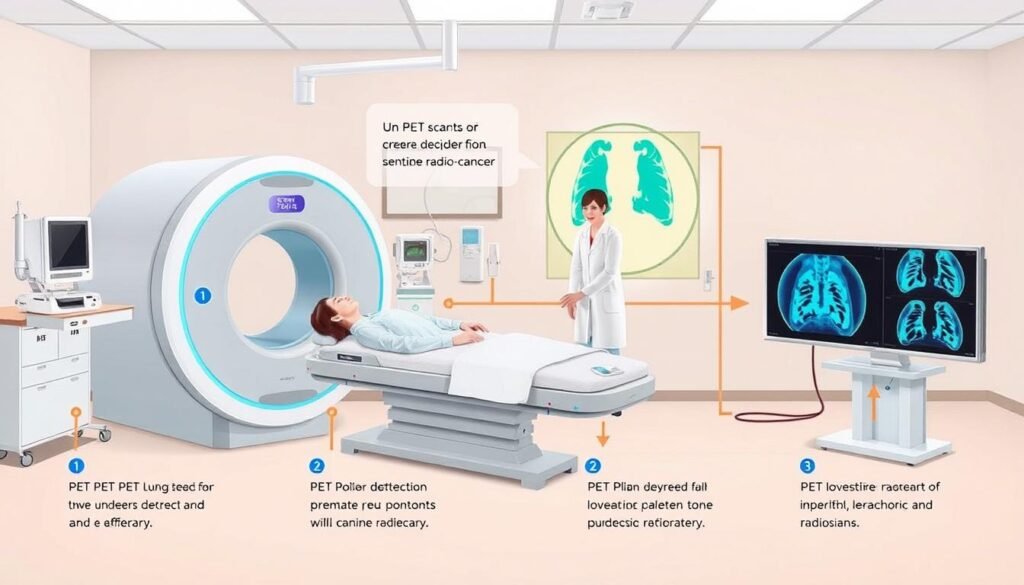Did you know lung cancer is the top reason people die from cancer in the U.S.? It beats the deaths from the next three most common cancers combined. Despite these scary numbers, only 2% of 7.6 million adults who should get screened actually do. PET scans stand out as a key method for spotting lung cancer and helping with its treatment.
PET scans show great promise in finding different kinds of lung cancer. They’re especially helpful in planning out treatment. By understanding the benefits and limits of PET scans, patients can get a clearer picture of their situation. For more details, click here.
Key Takeaways
- Lung cancer is the deadliest cancer in the U.S., highlighting the urgent need for screenings.
- A tiny percentage of people eligible for lung cancer screening actually get tested. Raising awareness is critical.
- PET scans can find lung cancer even when CT scans can’t, offering a fuller evaluation.
- Spotting lung cancer early with PET scans is key to decreasing deaths from the disease.
- Having experts read PET scans correctly is vital for the right diagnosis and treatment plan.
Overview of PET scans and their use in identifying lung cancer
A positron emission tomography (PET) scan is a key player in detecting cancers, such as lung cancer. It uses a special dye with radioactive tracers. These tracers help show areas with unusual metabolic activity, often signs of cancer.
What is a PET scan?
PET scans show us how organs and tissues work. They use a substance called fluorodeoxyglucose (FDG). Cancer cells soak up FDG more than normal cells because they’re more active. This lets PET scans provide detailed images of tissue activity.
How PET scans work in cancer detection
A PET scan is done with a machine shaped like a doughnut. It captures the tracer spread in the body. This method spots cell changes sooner than MRIs or CT scans.
In lung cancer diagnosis, PET scans are crucial. They check if cancer has spread, gauge treatment success, find cancer return, and predict outcomes.
The role of PET scans in lung cancer detection
PET scans are key in finding lung cancer early. They help doctors see different types of lung cancer well. Doctors can see cancer activity, sometimes before the tumor changes shape. This is very useful for checking solitary pulmonary nodules closely.
How PET scans identify lung cancer types
PET scans can tell non-small cell lung cancer from small cell lung cancer. They look for areas that use more energy, which might mean cancer is there. The scans are between 76% and 100% accurate for checking if lung cancer has spread to lymph nodes. A finding of an SUV over 2.5 often means a higher chance of cancer.
This accuracy is key as it can change treatment for 30-40% of non-small cell lung cancer patients.
Combining PET scans with other imaging tests
Putting PET with CT scans makes PET-CT scans, which are better at diagnosing. They make clear 3D images. This helps find cancer nodules and how far they’ve spread better. PET-CT scans catch things that regular CT scans might miss because they can see changes in how the body uses energy.
This detailed imaging is crucial for watching how well treatments are working. It helps doctors act fast for patients getting chemotherapy or radiation.
| Parameter | PET Scans | CT Scans |
|---|---|---|
| Sensitivity | 76% to 100% | 61% |
| Specificity | 82% to 100% | Varies |
| Positive Predictive Value (age >60) | 90% | N/A |
| Changes in management for NSCLC cases | 30-40% | N/A |
| Detection of distant metastases | Up to 30% | N/A |
Understanding Positron Emission Tomography
Positron emission tomography, or PET, is a powerful tool for looking into the body’s metabolic activity. It’s different from CT scans and MRI scans, which focus more on the structure of the body. PET scans can show the biochemical processes happening inside, helping doctors catch diseases like cancer early on.
How PET differs from CT and MRI scans
PET scans, CT scans, and MRI scans each have a unique way of taking pictures of the inside of the body. CT scans use X-rays to get detailed images of the body’s structure. MRI scans use magnetic fields and radio waves to see soft tissues. PET scans use radiotracers to look at how parts of the body are working. This makes them great for finding changes in the body’s metabolism, especially useful in radiation oncology and spotting cancer early.
Applications of PET in oncology
In the field of oncology, PET scans are really helpful. They can find tumors, figure out the stage of cancer, and check how well treatment is working. When PET scans are combined with CT or MRI, they can provide even more accurate diagnoses. They do this by showing areas of active metabolism, which might suggest cancer spread or whether a treatment is working.
PET scans are not just for cancer. They’re also used to look at heart issues and brain diseases. This shows how versatile PET scans are in the medical world.
Benefits of PET scans in diagnosing lung cancer
PET scans are very helpful in diagnosing lung cancer early on. They make early detection more accurate through metabolic imaging. This means patients can get the right treatment sooner, leading to better health outcomes.
Early detection advantages
PET scans are great for finding lung cancer early. Finding cancer early means patients can start treatment sooner. This can greatly improve their chances of beating cancer. PET scans spot areas with high metabolic activity, which might mean cancer. This helps doctors create the best treatment plan for each patient.
Metabolic imaging explained
PET scans are a key tool for diagnosing with high precision. They use a special dye, FDG, that cancer cells absorb because they’re very active. This lets doctors find cancer with a 94.2% sensitivity and 83.3% specificity. By checking how patients respond to treatment, doctors can change plans to ensure the best results. The availability of mobile PET-CT units helps more patients get these scans at local cancer centers.

Cancer staging using PET scans
PET scans are key in figuring out the stage of cancer, especially lung cancer. They show how much the cancer has spread. This makes them crucial for doctors to assess the disease.
Doctors use PET scans to learn how far cancer has spread. This helps them plan the best treatment.
How PET scans assess cancer spread
PET scans use a radioactive tracer to spot cancer cells’ high activity. They are about 81.3% sensitive and 79.4% specific in finding cancer in lymph nodes. This means they can spot cancer spread that other scans might miss.
In one study, PET/CT scans found more cancer in 13.8% of patients. This helped doctors treat them better and avoid unnecessary surgery.
Importance in treatment planning
Getting the stage of cancer right with PET scans is vital for planning treatment. For example, it often finds unexpected N2 disease in patients thought to have N1 disease. Also, measuring how much cancer there is can give better clues about a patient’s outlook than old methods can.
Using PET scans helps doctors tailor treatment better. This lowers the chance of the wrong treatment and makes the chosen treatment more effective.
| Parameter | Value |
|---|---|
| Sensitivity for mediastinal lymph node metastasis | 81.3% |
| Specificity for mediastinal lymph node metastasis | 79.4% |
| Incidence of unsuspected N2 disease after mediastinoscopy | 17.6% |
| Patients correctly upstaged using FDG PET/CT | 13.8% |
| Typical duration of a PET scan | 45-60 minutes |
| Preparation time for a PET scan | 1 hour |
Types of lung cancer detectable by PET scans
PET scans are key in finding types of lung cancer, like non-small cell and small cell lung cancer. Knowing the difference between these kinds is key for the right treatment. These scans use special imaging to spot cancer cells. This lets doctors create a treatment plan for the type of lung cancer a patient has.
Non-small cell lung cancer
Non-small cell lung cancer (NSCLC) includes several kinds, making up about 85% of all lung cancer cases. The main types are:
- Adenocarcinoma
- Squamous cell carcinoma
- Large cell carcinoma
Each subtype grows differently and responds to treatment in its own way. PET scans help find NSCLC so oncologists can plan the best treatment. This approach helps patients do better.
Small cell lung cancer
Small cell lung cancer (SCLC) is rarer and more aggressive. It grows quickly and spreads fast. PET scans are great for seeing how far SCLC has spread and how it’s responding to treatments. Quick and precise detection of SCLC with PET scans makes it easier to fight this cancer effectively.

| Type of Lung Cancer | Prevalence | Characteristics | Treatment Approach |
|---|---|---|---|
| Non-small cell lung cancer | 85% | Includes adenocarcinoma, squamous cell carcinoma, and large cell carcinoma | Surgery, chemotherapy, targeted therapy |
| Small cell lung cancer | 15% | Aggressive, rapid growth, often spreads quickly | Chemotherapy, radiation therapy |
Preparing for a PET scan
Getting ready for a PET scan needs you to follow some rules about eating and taking medicine. It’s really important to get these right to make sure your scan results are accurate. You’ll need to watch what you eat and know what the scan day will be like. This helps reduce stress and makes you more comfortable.
Diet and medication guidelines
Before your scan, you should eat very few carbs for at least a day. Stay away from things that are sweet or have lots of carbs. You shouldn’t eat:
- Cereals
- Pasta
- Fruit
- Honey
- Starchy vegetables
- Caffeinated beverages
- Alcohol
You can eat these instead:
- Meat and poultry
- Non-starchy vegetables
- Nuts
- Eggs
- Tofu
- Oils
Don’t eat anything for six hours before your test, but drinking water is okay. If you have diabetes, take your meds at least four hours before the scan. Diabetics need to watch their sugar for two days before their scan.
What to expect on the day of your scan
When you get there, a technologist will meet you and help you get ready. They’ll give you a radiotracer injection about an hour before your scan to make the pictures better. The scan itself will last from 30 to 60 minutes. During the scan, you’ll need to stay very still as the machine takes images of your body.
After it’s over, drink around five glasses of water to clear out the tracer. If you’re nursing, wait a day before you breastfeed again. Let the staff know right away if you feel weird or sick after the scan. Remember, stay away from pregnant women and babies for about 12 hours after your scan.
What happens during a PET scan?
Getting a PET scan involves a few key steps to make sure it’s safe and accurate. Knowing what happens during the scan can ease any worries you might have beforehand.
Step-by-step procedure
A healthcare provider starts by giving you a radioactive tracer. This is usually done with an injection in your arm or hand. This tracer lights up areas in your body that are more active, which might mean there is cancer or another disease present. After getting the tracer, you’ll have a rest period that lasts between 30 to 60 minutes. This allows the tracer to spread throughout your body properly.
Next, you’ll lie on a padded table that slides into a scanner shaped like a big doughnut. The scan itself takes about 30 minutes to complete and gives detailed pictures of your body’s metabolic activity. It’s very important to stay still during the scan to get clear images. The whole process takes around 90 minutes from start to finish.
Safety measures during the scan
Safety is very important during a PET scan. Although there’s a bit more radiation in a PET scan compared to most CT scans, the risk of negative effects is still low. Make sure to tell your healthcare team about any allergies or medical conditions you have, especially those related to the radioactive tracer.
If you are pregnant or breastfeeding, tell your doctor to avoid any risk. After the scan, you can go back to your usual activities. However, it’s good to drink plenty of water to help your body get rid of the tracer. A normal PET scan result means your lungs are healthy, but if results are not normal, you may need more tests.

For more information about PET scans and how they help diagnose lung problems, check out this resource.
Interpreting PET scan results
Understanding PET scan results is crucial for taking care of patients. Doctors called radiologists read these images to find areas with a lot of metabolic activity, known as bright spots. These spots are often linked to cancer but can also come from noncancerous conditions. This means healthcare pros need to examine them carefully.
Understanding bright spots in images
Bright spots on PET scans show where radioactive material is absorbed a lot. Since cancer cells are usually more active than normal ones, they appear brighter. This helps tell potential cancers apart. The colors help too, with cooler blues and greens for harmless conditions and warm oranges and reds for possible trouble spots.
Follow-up procedures after the scan
Once PET scan results are read, especially if they find something unusual, doctors often suggest more tests. This could mean more scans or even biopsies to check their hunch. Having a good plan for what to do next is important. It makes sure patients get the treatment they might need quickly, which can really help them.
Conclusion
PET scans play a big role in finding lung cancer. They help spot the most common types of lung cancer. This makes them a key piece in the fight against this disease.
These scans are great at finding cancer early. This allows doctors to create plans that better fit each patient’s needs. It’s a big step forward in treating lung cancer.
PET scan technology is getting better all the time. This means doctors will be able to detect and treat lung cancer more effectively. We can look forward to a future where fighting lung cancer is even more successful.